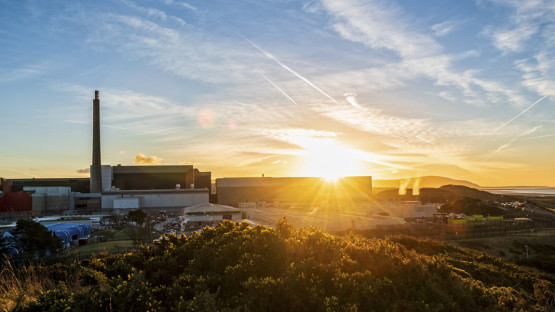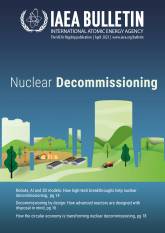
If you would like to learn more about the IAEA’s work, sign up for our weekly updates containing our most important news, multimedia and more.
Nuclear Decommissioning Market Set to Boom
Emma Midgley, Joanne Burge

Decommissioning at the Sellafield site in the UK is expected to last many decades. (Photo: Sellafield Ltd.)
As many nuclear power plants (NPPs) around the world near the end of their life cycle, a new industry based around decommissioning nuclear facilities is emerging. In addition to NPPs, many other facilities involved in the nuclear fuel cycle, such as research centres and facilities for reprocessing spent fuel or for waste treatment, will need to be decommissioned when they reach end of life. In total, it is likely that several hundred billion dollars will be spent on decommissioning worldwide between now and 2050, and businesses and investors are already securing their positions.
There are around 420 nuclear power reactors currently in operation around the world. Around 200 nuclear reactors are expected to begin the decommissioning process by 2050. In addition to the work of decommissioning the reactors (projects which may last 20 years or more from start to finish), decommissioning expertise is also required in the design of new nuclear facilities. There are currently over 50 reactors under construction globally. Before they were constructed, each of these required a decommissioning plan to be in place. The decommissioning industry, therefore, looks to have strong long-term prospects.
“ [The IAEA International Decommissioning Network] helps disseminate information relevant to the decommissioning process, such as the sharing of best practices and innovations, to enhance cooperation and coordination in the decommissioning industry around the world.
Nuclear engineering, construction, demolition and waste management companies are expected to be the main service providers to the decommissioning industry. Their role will be to decontaminate and dismantle nuclear facilities and to rehabilitate sites for a safe, useful future, taking into account sustainability and socio-economic factors. Nuclear facilities must also be dismantled and made safe in a way which considers environmental impacts, in line with circular economy principles, including by recycling recovered metals, wires and cables, and segregating clean concrete from reinforcement steel concrete. At the same time, this complex task requires a highly skilled nuclear workforce, which must be expanded in order to avoid a nuclear skills shortage in the future.
In order to retain knowledge and advance the industry, the IAEA International Decommissioning Network provides a forum for organizations and individuals involved in the decommissioning and dismantling of nuclear facilities to share experiences and lessons learned. The IAEA assists countries in the planning and implementation of decommissioning by providing safety, legal and technical advice, and by supporting knowledge sharing through training courses and workshops. It plays an important role in facilitating broad international collaboration, as well as conducting technical reviews to establish good practices and to ensure that lessons are learned from experience.
“The network brings together organizations and individuals involved in the decommissioning and dismantling of nuclear facilities,” said Tetiana Kilochytska, a Decommissioning Specialist at the IAEA. “It helps disseminate information relevant to the decommissioning process, such as the sharing of best practices and innovations, to enhance cooperation and coordination in the decommissioning industry around the world.”
One of the oranizations sharing its expertise for the benefit of others is the organization responsible for the Sellafield site in the United Kingdom. The site has hosted a range of nuclear facilities, such as nuclear power reactors, fuel reprocessing facilities and waste treatment plants. When it opened in the 1950s, Calder Hall on the Sellafield site was the first commercial nuclear power station in the world. The large range of aged nuclear facilities on a compact footprint means the decommissioning professionals working site has had to develop innovative and unique solutions during decommissioning, including digitalization and robotics.
“It is a very complex nuclear decommissioning challenge,” said Mike Guy of Sellafield Limited.
“That is due to the large number and diverse nature of the facilities in close proximity on a congested site. We must deal with a wide range of waste challenges, including waste that has been stored in underwater ponds and the removal of waste from very large and complex cells.”
Decommissioning at the Sellafield site began in the 1980s and is expected to continue throughout this century, and even beyond. This wealth of experience means that Sellafield is in an ideal position to share its unique expertise and experiences with the international decommissioning community. It has already implemented new processes to simplify and accelerate the treatment of radioactive waste at legacy sites, and shared its knowledge on the dismantling of structures in order to help engineers design facilities which are easier to deconstruct.
In addition, investment in supply chains that work with Sellafield Limited shows the potential financial benefits for companies entering the nuclear industry. In 2021, the United Kingdom’s Nuclear Decommissioning Authority, the public body which oversees decommissioning at the Sellafield site, spent around 55 per cent of its 4 billion US dollar annual budget on services provided by partner companies.
Accelerated decommissioning
The experience gained from implementing decommissioning programmes over several years is increasingly being used to shorten the duration of decommissioning projects. Reducing the number of years spent on various projects can achieve significant budget reductions, as labour costs account for a large proportion of the cost of a project. Decommissioning projects that have recently been launched for commercial power reactors in the United States of America aim to reduce the duration of the main phase of dismantling (not including activities related to licence termination) to between five and seven years, which is about half the current global average duration for this phase of activity.
By optimizing the interaction between the main project activities and dismantling and waste management, it is possible to shorten the length of time required for the completion of projects. Good project management and good relationships between the facility owner and the supply chain are vitally important. Major programmes, such as that at Sellafield, typically aim to develop long-term partnering approaches with the supply chain, based on contracts with durations of up to a decade.
Achieving early authorization for decommissioning also helps to reduce the length of time required to achieve the release of the facility from regulatory control. Recent programmes in Germany aim to obtain decommissioning authorizations at about the same time as the permanent shutdown of the facility. Such an approach requires that detailed planning activities and associated safety assessments are undertaken prior to the facility being permanently shut down.
Decommissioning projects produce extremely large quantities of material that need to be managed effectively. Having the opportunity to recycle or reuse a large amount of this material and being able to quickly dispose of material that must be managed as waste is also key to reducing overall costs, and is a significant contributory factor for future accelerated decommissioning.






